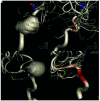Predictors of the Effects of Flow Diversion in Very Large and Giant Aneurysms
- PMID: 33926897
- PMCID: PMC8191680
- DOI: 10.3174/ajnr.A7085
Predictors of the Effects of Flow Diversion in Very Large and Giant Aneurysms
Abstract
Background and purpose: The treatment paradigm for very large and giant aneurysms has recently changed to flow diversion, in light of the results of the Pipeline for Uncoilable or Failed Aneurysms trial. However, the effects of flow diversion were definitely unknown. We explored this topic and identified the predictors of such effects.
Materials and methods: We retrospectively reviewed 51 patients with unruptured aneurysms admitted to our institution for flow diversion between February 2014 and August 2019. Patients were categorized into an effect group (no filling or remnant entry) and a no-effect group (subtotal or total filling). We evaluated the aneurysm size and shape, incorporation vessel, parent artery stenosis and curvature, stagnation of contrast medium within the aneurysm, use of balloon angioplasty, and intra-aneurysm thrombus as potential predictors of the effects of flow diversion.
Results: The effect group comprised 34 patients (66.7%, 34/51; no filling, 35.3%, 18/51; and remnant entry, 31.4%, 16/51). The no-effect group comprised 17 patients (33.3%, 17/51; subtotal filling, 29.4%, 15/51; and total filling, 3.9%, 2/51). An incorporation vessel and balloon angioplasty were independent risk factors for the no-effect group in multivariate logistic regression analyses (OR = 0.13 and 0.05; 95% confidence intervals, 0.02-0.62 and 0.00-0.32; P values, .021 and .004, respectively).
Conclusions: Flow diversion is effective for very large and giant aneurysms, but the outcomes require further improvement. The results of this study show that an incorporated vessel and excessive balloon angioplasty might compromise flow diversion. This finding can help improve the outcomes of flow diversion.
© 2021 by American Journal of Neuroradiology.
Figures



Similar articles
-
Evaluation of the Significance of Persistent Remnant Filling and Enlargement After Flow Diversion for Intracranial Aneurysms.World Neurosurg. 2024 Apr;184:e144-e153. doi: 10.1016/j.wneu.2024.01.073. Epub 2024 Jan 20. World Neurosurg. 2024. PMID: 38253178
-
Treatment Outcomes After Single-Device Flow Diversion for Large or Giant Aneurysms.World Neurosurg. 2021 Sep;153:e36-e45. doi: 10.1016/j.wneu.2021.06.009. Epub 2021 Jun 12. World Neurosurg. 2021. PMID: 34129984
-
Pipeline for uncoilable or failed aneurysms: 3-year follow-up results.J Neurosurg. 2017 Jul;127(1):81-88. doi: 10.3171/2015.6.JNS15311. Epub 2016 Oct 14. J Neurosurg. 2017. PMID: 27739944
-
Flow Diversion in the Treatment of Intracranial Aneurysms: A Pragmatic Randomized Care Trial.AJNR Am J Neuroradiol. 2022 Sep;43(9):1244-1251. doi: 10.3174/ajnr.A7597. Epub 2022 Aug 4. AJNR Am J Neuroradiol. 2022. PMID: 35926886 Free PMC article. Review.
-
Endovascular treatment of complex intracranial aneurysms by pipeline flow-diverter embolization device: a single-center experience.Neurol Res. 2015 Apr;37(4):359-65. doi: 10.1179/1743132814Y.0000000450. Epub 2014 Oct 13. Neurol Res. 2015. PMID: 25310354 Review.
Cited by
-
Safety and efficacy of Surpass Evolve Flow diverter for intracranial aneurysms: A study of 116 patients.Neuroradiol J. 2024 Apr;37(2):184-191. doi: 10.1177/19714009231224408. Epub 2023 Dec 26. Neuroradiol J. 2024. PMID: 38146676 Free PMC article.
-
Flow Diversion for Cerebral Aneurysms: A Decade-Long Experience with Improved Outcomes and Predictors of Success.Brain Sci. 2024 Aug 22;14(8):847. doi: 10.3390/brainsci14080847. Brain Sci. 2024. PMID: 39199538 Free PMC article.
-
A Long-Term Comparative Analysis of Endovascular Coiling and Clipping for Ruptured Cerebral Aneurysms: An Individual Patient-Level Meta-Analysis Assessing Rerupture Rates.J Clin Med. 2024 Mar 20;13(6):1778. doi: 10.3390/jcm13061778. J Clin Med. 2024. PMID: 38541999 Free PMC article. Review.
-
Treatment Outcomes of 94 Cases of Pipeline Embolization Device in a Single Center: Predictive Factors of Incomplete Aneurysm Occlusion.J Neuroendovasc Ther. 2023;17(10):217-223. doi: 10.5797/jnet.oa.2023-0027. Epub 2023 Aug 15. J Neuroendovasc Ther. 2023. PMID: 37869485 Free PMC article.
-
Treatment of giant intracranial aneurysms using the Pipeline flow-diverting stent: Long-term results from the International Retrospective Study of the Pipeline Embolization Device (IntrePED) study.Interv Neuroradiol. 2024 Apr;30(2):218-226. doi: 10.1177/15910199221123282. Epub 2022 Sep 27. Interv Neuroradiol. 2024. PMID: 36168255 Free PMC article.
References
-
- Lemole GM, Henn J, Spetzler RF, et al. . Surgical management of giant aneurysms. Operative Techniques in Neurosurgery 2000;3:239–54 10.1053/otns.2000.20464 - DOI
-
- Sano H. Treatment of complex intracranial aneurysms of anterior circulation using multiple clips. In: Laasko A, Hernesniemi C, Yonekawa Y, et al., eds. Surgical Management of Cerebrovascular Disease: Acta Neurochirurgica Supplementum. SpringerWien; 2010; 27–31 - PubMed
-
- Molyneux A, Kerr R, Stratton I, et al. . International Subarachnoid Aneurysm Trial (ISAT) Collaborative Group. International Subarachnoid Aneurysm Trial (ISAT) of neurosurgical clipping versus endovascular coiling in 2143 patients with ruptured intracranial aneurysms: a randomized trial. J Stroke Cerebrovasc Dis 2002;11:304–14 10.1053/jscd.2002.130390 - DOI - PubMed
MeSH terms
LinkOut - more resources
Full Text Sources
Other Literature Sources
Medical
